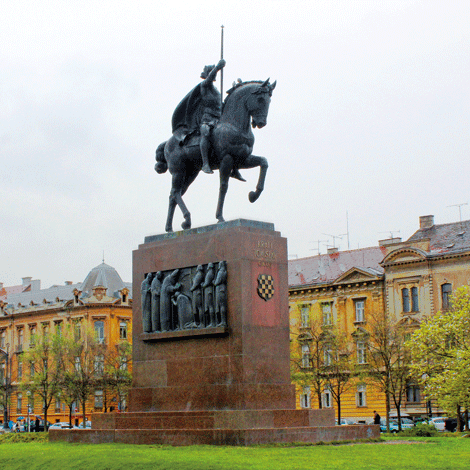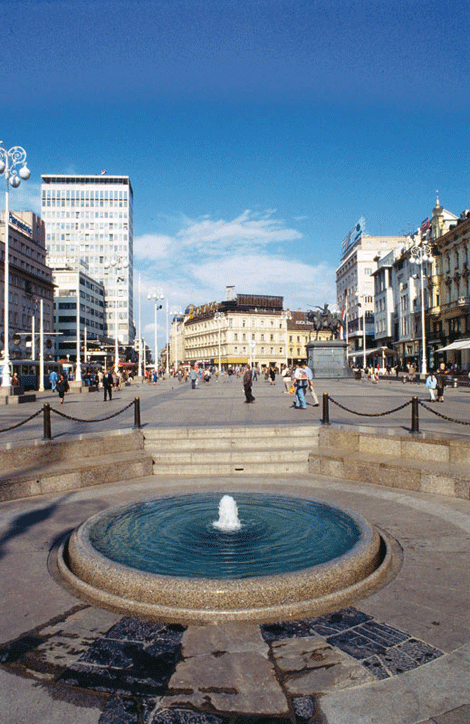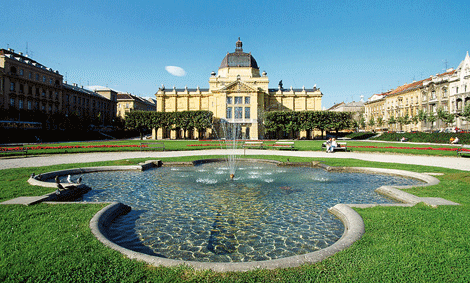
The historic heart of Zagreb, the capital of Croatia, is essentially two cities. There is the Upper Town, with a history dating back 1,000 years, and the Lower Town, which is defined by a sort of giant green horseshoe. A network of 30 parks and civic buildings, the horseshoe was designed by urban planner Milan Lenuci (1849–1924). Running through the Lower Town’s heart, it looks like a huge, vibrant green “U” if viewed from the air.
Three squares and several important buildings, mostly in the art nouveau style, comprise the horseshoe’s western flank. Counted among the more notable structures are the Croatian National Theatre and the State Archives. Two-thirds of the southern flank is composed of the Botanical Gardens. Zagreb’s green lung, the gardens are home to more than 10,000 plant species – as well as countless ducks, which paddle and quack among the water lilies.
The city’s premier hotel, the Regent Esplanade Zagreb, is located at the eastern end of this southern flank. It was built in 1925 to serve railway passengers arriving on the Orient Express, who would disembark at the nearby main train station, just a short walk to the east of the hotel.
A statue of King Tomislav, Croatia’s first medieval king, is situated directly in front of the station. Riding a steed with right arm raised and holding a sceptre, the king – whose back is to the station – seems to be leading disembarking passengers into the city, up the horseshoe’s leafy eastern flank, which contains three more squares and several more important buildings.

Situated at the top of the eastern flank is Ban Jelacic Square, which has served as the commercial heart of Zagreb since the 17th century. Here you will find banks and office buildings, department stores and other commercial establishments.
“Zagreb is still undiscovered, and this gives it a certain charm,” says Ivica Krizmanic, acting general manager of the Regent Esplanade Zagreb. “There are no major industrial zones, no traffic jams to destroy the romance – indeed, everything is close and exactly as it should be. It’s really easy to walk around.”
Historic Zagreb
Every evening at dusk, two men in colourful uniforms march solemnly through the cobblestone streets and alleys of the Upper Town. One by one, they light the roughly 200 gas lamps that illuminate the medieval district after dark. The procedure is repeated in reverse at dawn, with two men extinguishing the lamps as the district slowly awakens to the cackling of roosters and the barking of dogs.
In the distance lies Medvedgrad, a medieval fortress located halfway between Zagreb and the peak of a nearby mountain. It was built following the Mongol invasion of the region in 1242, when the city was burned to the ground.
With a history dating back more than 1,000 years, the Upper Town is dripping with steepled churches, leafy parks, proud statues, majestic arches, and the remnants of forts and city walls that were built to protect the strategically located city from invasion.
Towering over Kaptol, which is just north of Ban Jelacic Square, is the Cathedral of the Assumption of the Blessed Virgin Mary, whose Catholic pedigree dates back to the founding of the city 1,000 years ago. Early structures, dating from the 11th through 19th centuries, were largely destroyed by a massive earthquake in 1880.
The cathedral’s imposing neo-Gothic, twin-towered architecture, which now dominates the site, was built in the twilight hours of the 19th century. Currently undergoing renovation, it has a baroque façade, which has been recently re-clad in stone that will hopefully be more durable than the original. Its interior, meanwhile, has been painstakingly restored to its former glory.
“Do you see those chandeliers?” whispers tour guide Doris Kunkera as parishioners pray, light candles and make offerings. “They were obtained from a casino on the Las Vegas Strip.” Strangely enough, the heavy metal chandeliers look perfectly at home dangling from the vaulted ceiling of that hauntingly beautiful place of religious worship. Sin City’s loss was clearly Zagreb’s gain!
The jewel in Zagreb’s historic crown is St Mark’s Square. Situated in the heart of the Upper Town, it is dominated by St Mark’s Church, one of the loveliest churches in all Europe. Started in the 13th century, St Mark’s was substantially rebuilt in a Gothic style in the 19th century, and it was then that its hallmark, the stunningly beautiful glazed roof tiles with coats of arms of the three kingdoms – Croatia, Dalmatia and Slavonia – and the city of Zagreb, was added. The seat of the government of Croatia and the Croatian parliament are also located in the square.

Cultural Zagreb
The Lower and Upper cities are dotted with dozens of museums, galleries and collections. From an architectural standpoint, the Art Pavilion – situated near the base of the horseshoe on its eastern flank – is surely the most interesting. The oldest exhibition space in southeastern Europe, it was modelled on the Croatian Pavilion at the 1896 Millennium Exhibition in Budapest, Hungary.
As with all municipal buildings in the city from that era, its exterior is painted a deep yellow, which was mandated by Queen Maria Teresa (1717–1780), queen of Hungary and Croatia in the late 18th century. “There are different theories as to why civic buildings in Zagreb were all painted this shade of yellow,” Kunkera says. “Some people think it was Maria Teresa’s favourite colour. Others think it was because it was the colour of gold. Most probably, however, it was the cheapest colour of paint.”
One of Zagreb’s most important museums is the Mimara Museum. Housed in a neo-Renaissance palace, it has 3,750 works on display. Included are 450 paintings and drawings from the Great Masters and 200 sculptures dating all the way back to Classical antiquity.
The Croatian Museum of Naïve Art is noteworthy because it is believed to be the world’s first museum dedicated to works created by artists with no formal training. Most of the displayed pieces were created by Croatian artists between 1930 and 1980, but foreign artists’ creations are also featured.
Unlike most of the other museums in the city, the Museum of Contemporary Art – located to the south of the Sava River – is housed in a stunning contemporary structure, reflecting its mission to analyse, document and promote the works of Croatian and international artists from 1950 onwards. Among the 12,000 exhibits on display are drawings, graphics, paintings, sculptures, films, videos – the list goes on.
The breakup of two Croatian artists in 2003 led to a travelling exhibition of objects representing relationships that had failed. These objects – together with short essays as to what they represent – have found a permanent home in the award-winning Museum of Broken Relationships, where visitors are invited to leave comments of their own failed relationships on their way out.
“With the opening of the Museum of Contemporary Art and the Museum of Broken Relationships, Zagreb’s stock as an international tourist destination rose considerably,” says Englishman Jonathan Bousfield, who has lived in the city for three years. “Already blessed with a cutting-edge art scene, the Croatian capital is now able to offer the layman a cultural weekend equal to almost any in the region.”

Hip Zagreb
According to the Zagreb Tourist Board, the city has five major discos, 15 clubs, 12 pubs, dozens of beer houses, numerous cocktail lounges, several jazz clubs and countless coffee houses. And then there are the 15 casinos.
“Cutting-edge art, hyper-modern bars and the latest fashions blend with more traditional offerings in Zagreb, a city that has something for everyone,” Bousfield says. “Locals relax on café terraces and lovers stroll round the twin-towered cathedral while shoppers browse the stalls of the Dolac Market, which brims with fresh local produce.”
As soon as spring arrives, cafés, restaurants, bars, pubs and fast-food joints start setting up chairs and tables out front. While they can be found throughout both the Lower and Upper towns, one of the most interesting concentrations of social life can be found on picturesque Tkalciceva Street, which is also scattered with small boutiques, traditional shops, tiny bookstores and the occasional outlet selling souvenirs.
After sunset, hedonistic types head to the many clubs that dot the city. Hemingway Bar and Peppermint are popular with locally based expatriates, visiting businessmen, and locals who enjoy showing off. If Hemingway leans toward funky rhythms and electro house music, a visit to Peppermint – with its 60s soul music, 70s disco and 80s rap – is more like a walk down memory lane. Both are said to serve the best cocktails in town.
But some locals find Hemingway and Peppermint a bit snobbish – not to mention pricey. They recommend heading to one of the many other laid-back clubs that dot the city. KSET, which stands for Club of Students of Electrical Engineering, is a key example. Here you can enjoy everything from drum’n’bass to underground movies.
The Croatian Musicians’ Club, popularly known as SAX, is also highly recommended. There you’ll find a unique blend of soul and blues, with almost nightly concerts by domestic and international bands. “SAX is a very popular nightclub with live music in the downtown area,” says Al Jazeera Network’s Danko Njers, who grew up in the city and is currently based in Doha, Qatar. “That’s where you can get a real slice of Croatian life.”
The future
May 9, 2012 marked a key milestone in Zagreb’s march into the future with the inauguration of daily flights linking the city with Budapest, Hungary, and Doha, Qatar, via Qatar Airways.
“The new connection is important in many ways,” says Amelia Tomasevic, chief executive of the Zagreb Tourist Board. “The new service will allow passengers from Croatia to transit via Doha and connect to Qatar Airways’ flights to Asia, but also further afield to Melbourne and Perth [in Australia].”
With a population of 4.5 million, Croatia is an important market for investment and consumer goods. Because of its highly educated workforce, it has tremendous potential for multinationals – in both the manufacturing and service industries.
“Reforms in all sectors of the economy and entry into the European Union in 2013 offer manifold new market and investment opportunities for international companies,” Tomasevic says. “Croatia is an economic hub for neighbouring states in Southeast Europe – Slovenia, Serbia, Montenegro, Bosnia and Herzegovina – which are home to 23 million people.”
Paul Johannes, vice-president – commercial Europe of Qatar Airways, believes the new link will prove popular with travellers from Asia, who can start or end their European tours in Croatia.
ZAGREB AT A GLANCE
Location: The capital of Croatia, Zagreb is also the country’s most populous city. Located along the Sava River on the southern slopes of Medvednica mountain, Zagreb has a population of between 700,000 and 800,000 people, while the entire metropolitan area brings the figure to more than 1.1 million people. The country has a total population of 4.5 million.
Weather: Zagreb has four distinct seasons. Winters are cold, with average temperatures just below freezing. Summers are mild, with an average temperature of 22?C.
Transport: Zagreb has a well-developed transport system, with 19 inner city tram lines and 120 bus routes. It has an international airport serving more than two million passengers a year. This capacity will be more than doubled when an expansion project is completed in 2016.
Website: www.zagreb.com
HOTEL HIGHLIGHTS
Regent Esplanade Zagreb – There are 208 rooms and suites, a fitness centre and spa, facilities for meetings and conferences, and four food and beverage outlets. With its modern take on traditional Croatian cuisine, the hotel’s fine dining outlet Zinfandel’s is considered one of the top restaurants in the country.
Tel +385 1 456 6666, www.regenthotels.com/en/zagreb
Sheraton Zagreb HoteL – Located in the centre of town, the Sheraton Zagreb Hotel has 306 rooms and suites, 17 meeting rooms, an 800 sqm ballroom, and four food and beverage outlets as well as an indoor swimming pool, fitness facilities and a casino.
Tel +385 1 455 3535, www.sheraton.com/zagreb
The Westin Zagreb – The Westin Zagreb is also located in the centre of town, with 378 rooms and suites, conference rooms, three ballrooms, an indoor swimming pool, fitness centre and spa, plus three food and beverage outlets.
Tel +385 1 489 2000, www.hotelwestinzagreb.com








